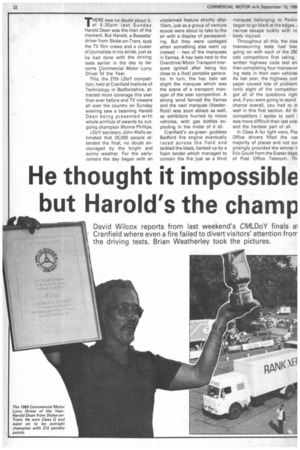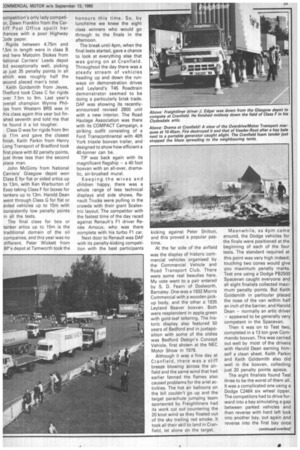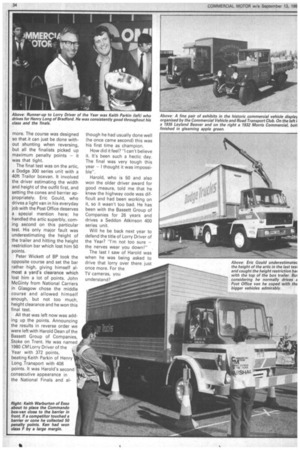He thought it impossible but Harold's the champ
Page 34

Page 35

Page 36

If you've noticed an error in this article please click here to report it so we can fix it.
'THERE was no doubt about it, 1 at 6.30pm last Sunday Harold Dean was the man of the moment. But Harold, a Bassetts' driver from Stoke-on-Trent, took the TV film crews and a cluster of journalists in his stride, just as he had done with the driving tests earlier in the day to become commercial Motor Lorry Driver bf the Year.
This, the 27th LDoY competition, held at Cranfield Institute of Technology in Bedfordshire, attracted more coverage this year than ever before and TV viewers all over the country on Sunday evening saw a beaming Harold Dean being presented with whole armfuls of awards by outgoing champion Wynne Phillips.
l_DoY secretary John Wells estimated that 25,000 people attended the final, no doubt encouraged by the bright and sunny weather. For the earlycorners the day began with an
unplanned feature shortly after 10arn, just as a group of venture scouts were about to take to the air with a display of parascending. But they were upstaged when something else went up instead — two of the marquees in flames. A hay bale next to the Overdrive/Motor Transport marquee ignited after being too close to a (hot) portable generator. In turn, the hay bale set alight the marquee which was the scene of a transport manager of the year competition. A strong wind fanned the flames and the next marquee (VeederRoot) was soon ablaze as well, as exhibitors hurried to move vehicles, with gas bottles exploding in the midst of it all.
Cranfield's ex-green goddess Bedford fire engine eventually raced across the field and tackled the blaze, backed up by a foam tender which managed to contain the fire just as a third marquee belonging to Perkin began to go black at the edges. ■ narrow escape luckily with nc body injured.
Throughout all this, the clas manoeuvring tests had bee going on with each of the 28C odd competitors first taking written highway code test an then completing four manoeuvi ing tests in their own vehicle: As last year, the highway cod paper caused lots of problem (only eight of the competitor got all of the questions righi and, if you were going to stand chance overall, you had to dl well in this first section. All th competitors I spoke to said was more difficult than last yea' and the hardest part of all.
In Class A for light vans, Pot Office drivers filled the vas majority of places and not sur prisingly provided the winner Eric Gould from the Exeter dope of Post Office Telecom. Thl ;ompetition's only lady competior, Dawn Franklin from the Carliff Post Office spoilt her :hances with a poor Highway :ode paper.
Rigids between 4.75m and 7.5m in length were in class B ind here Malcolm Stokes from Vational Carriers' Leeds depot Jid exceptionally well, picking Jp just 35 penalty points in all Nhich was roughly half the 5econd placed man's total.
Keith Goldsmith from Jeyes, Thetford took Class C for rigids aver 7.5m to 9m. Last year's averall champion Wynne Philips from Western BRS was in this class again this year but finished seventh and told me that he found it a lot tougher.
Class D was for rigids from 9m to 11rn and gave the closest Finish. Keith Parkin from Henry Long Transport of Bradford took first place with 82 penalty points, just three less than the second place man.
John McGinty from National Carriers' Glasgow depot won Class E for flat or sided artics up to 13m, with Ken Warburton of Esso taking Class F for boxes for tankers up to 13m. Harold Dean went through Class G for flat or sided vehicles up to 15m with consistently low penalty points in all the tests.
The final class for box or tanker artics up to 15m is the traditional domain of the oil companies, and this year was no different. Peter Wickett from BP's depot at Tamworth took the honours this time. So, by lunchtime we knew the eight class winners who would go through to the finals in the afternoon.
The break until 4pm, when the final tests started, gave a chance to look at everything else that was going on at Cranfield. Throughout the day there was a steady stream of vehicles heading up and down the runways on demonstration drives and Leyland's T45 Roadtrain demonstrator seemed to be doing a particularly brisk trade. DAF was showing its recentlyannounced revised 2800 unit with a new interior. The Road Haulage Association was there with its COMPACT Campaign, a striking outfit consisting of a Ford Transcontinental with 40ft York triaxle boxvan trailer, and designed to show how efficient a 40-tonner can be.
TIP was back again with its magnificent flagship — a 40 foot boxvan with an all-over, dramatic, air-brushed mural.
Keeping the wives and children happy, there was a whole range of less technical displays and side shows. Renault Trucks were pulling in the crowds with their giant Scalextric layout. The competitor with the fastest time of the day raced against Renault's Fl driver Renee Arnoux, who was there complete with his turbo Fl car.
Next door to Renault was OAF with its penalty-kicking competition with the best participants kicking against Peter Shilton, and this proved a popular pastime.
At the far side of the airfield was the display of historic commercial vehicles organised by the Commercial Vehicle and Road Transport Club. There were some real beauties here. My vote went to a pair entered by S. D. Fearn of Dodworth, Barnsley. One was a 1932 Morris Commercial with a wooden pickup body, and the other a 1935 Leyland Beaver boxvan, Both were resplendent in apple. green with gold-leaf lettering. The historic display also featured 50 years of Bedford and in juxtaposition with some of the oldies was Bedford Design's Concept Vehicle, first shown at the NEC Motor Show in 1978.
Although it was a fine day at Cranfield, there was a stiff breeze blowing across the airfield and the same wind that had earlier fanned the flames also caused problems for the ariel activities. The hot air balloons on the bill couldn't go up and the target parachute jumping team sponsored by Freightliners had its work cut out countering the 20 knot wind as they floated out of the sky trailing red smoke. It took all their skill to land in Cranfield, let alone on the target. Meanwhile, as 4pm came around, the Dodge vehicles for the finals were positioned at the beginning of each of the four tests. The standard required at this point was very high indeed; touching two cones would give you maximum penalty marks. Test one using a Dodge P52500 Spacevan caught everyone and all eight finalists collected maximum penalty points. But Keith Goldsmith in particular placed the nose of the van within half an inch of the barrier, and Harold Dean — normally an artic driver — appeared to be generally very competent in the Spacevan.
Then it was on to Test two, completed in a 13 ton gvw Commando boxvan. This was carried out well by most of the drivers with Harold Dean earning himself a clean sheet. Keith Parkin and Keith Goldsmith also did well in the boxvan, collecting just 20 penalty points apiece.
The eight finalists found Test three to be the worst of them all. It was a complicated one using a Dodge C2464 six wheel tipper. The competitors had to drive forward into a bay simulating a gap between parked vehicles and then reverse with hard left lock into another bay, out again and reverse into the first bay once more. The course was designed so that it can just be done without shunting when reversing, but all the finalists picked up maximum penalty points — it was that tight.
The final test was on the artic, a Dodge 300 series unit with a 40ft Trailor boxvan. It involved the driver estimating the width and height of the outfit first, and setting the cones and barrier appropriately. Eric Gould, who drives a light van in his everyday job with the Post Office deserves a special mention here; he handled the artic superbly, coming second on this particular test. His only major fault was underestimating the height of the trailer and hitting the height restriction bar which lost him 50 points.
Peter Wickett of BP took the opposite course and set the bar rather high, giving himself almost a yard's clearance which lost him a lot of points. John McGinty from National Carriers in Glasgow chose the middle course and allowed himself enough, but not too much, height clearance and he won this final test.
All that was left now was adding up the points. Announcing the results in reverse order we were left with Harold Dean of the Bassett Group of Companies, Stoke on Trent. He was named 1980 CM Lorry Driver of the Year with 372 points, beating Keith Parkin of Henry Long Transport with 408 points. It was Harold's second consecutive appearance in the National Finals and al though he had usually done well (he once came second) this was his first time as champion.
How did it feel? "I can't believe it. It's been such a hectic day. The final was very tough this year — I thought it was impossible".
Harold, who is 50 and also won the older driver award for good meaure, told me that he knew the highway code was difficult and had been working on it, so it wasn't too bad. He has been with the Bassett Group of Companies for 26 years and drives a Seddon Atkinson 400 series unit.
Will he be back next year to defend the title of Lorry Driver of the Year? "I'm not too sure — the nerves wear you down!"
The last I saw of Harold was when he was being asked to drive that lorry over there just once more. For the TV cameras, you understand?












































































































